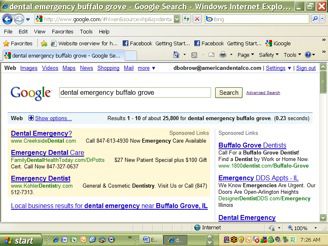With the economic prosperity of the eighties, and advances in esthetic dentistry and technology, many dentists became of the opinion that treating new patient emergencies was a waste of the dentist’s and team’s time. Symptomatic of this is what one heard when calling such a dental practice after hours: “If you are a patient of record with an extreme dental emergency you may call xxx-yyy-zzzz.” New patients were deliberately discouraged from calling.
With the economic prosperity of the eighties, and advances in esthetic dentistry and technology, many dentists became of the opinion that treating new patient emergencies was a waste of the dentist’s and team’s time.
Symptomatic of this is what one heard when calling such a dental practice after hours:
“If you are a patient of record with an extreme dental emergency you may call xxx-yyy-zzzz.”
New patients were deliberately discouraged from calling.
Today, many practitioners have been reminded and recognize that emergencies represent a singular opportunity to establish a solid, long term relationship with a new patient.
William McCune, whose practice Creekside Dental is located in Buffalo Grove, IL says: “When I started in ’87, I built my practice on needs, not wants, and the most commonly expressed need is a need to be relieved of pain. I can think of no better way to win a patient’s trust than to relieve their discomfort. That’s all the more true if they already have a dentist, but that dentist will not or cannot see them.”
To illustrate the positive impact welcoming emergencies can have on a practice, McCune shares that, in one week in March of this year, he performed more root canals and other emergency treatment than he did in an entire quarter last year “…because I am not shy about letting my patients and my community know I am here to serve their immediate needs.”
Among the techniques McCune employs is adding variations of the term ‘dental emergency’ to his Google adwords campaign, and including a telephone number in the ad:

With the economic prosperity of the eighties, and advances in esthetic dentistry and technology, many dentists became of the opinion that treating new patient emergencies was a waste of the dentist’s and team’s time.
Symptomatic of this is what one heard when calling such a dental practice after hours:
“If you are a patient of record with an extreme dental emergency you may call xxx-yyy-zzzz.”
New patients were deliberately discouraged from calling.
Today, many practitioners have been reminded and recognize that emergencies represent a singular opportunity to establish a solid, long term relationship with a new patient.
William McCune, whose practice Creekside Dental is located in Buffalo Grove, IL says: “When I started in ’87, I built my practice on needs, not wants, and the most commonly expressed need is a need to be relieved of pain. I can think of no better way to win a patient’s trust than to relieve their discomfort. That’s all the more true if they already have a dentist, but that dentist will not or cannot see them.”
To illustrate the positive impact welcoming emergencies can have on a practice, McCune shares that, in one week in March of this year, he performed more root canals and other emergency treatment than he did in an entire quarter last year “…because I am not shy about letting my patients and my community know I am here to serve their immediate needs.”
Among the techniques McCune employs is adding variations of the term ‘dental emergency’ to his Google adwords campaign, and including a telephone number in the ad:

The tactic entails bidding for the terms an emergency patient might use, and including a telephone number in the resulting ad, making it quick and convenient for the patient to reach the practice. This can have the added benefit of reducing your outlay for paid search because Google does not charge for impressions, but only clicks, to your website (hence the name pay per click). So, if someone calls, instead of clicking, no fee is assessed.
Emergency patients also represent an opportunity to diagnose and deliver complete as opposed to ‘patchwork’ dentistry.
Pain is not the only thing that can hurt
Dr. John Cranham, Clinical Director at The Dawson Academy, who practices in Chesapeake, VA, says: “Sometimes front desk people assume there must be pain for there to be an emergency. It can also be esthetic. Consider a patient who breaks a tooth just before her wedding. To her, that’s an emergency.”
According to Cranham “The emergency appointment is an opportunity to educate your patients about your philosophy and commitment to complete dentistry. Be sure to have, and promote, a policy which states your commitment to seeing patients with an emergency as soon as possible.”
Avoid tunnel vision
Not withstanding such innovations as CAD CAM dentistry, it’s important to recognize that, if the emergency is not a patient of record who you’ve seen regularly and, therefore, whose dental history you know, delivering a permanent restoration is probably inappropriate. Only a comprehensive exam will determine for example, if the tooth is compromised in other ways. You can do a quick, but effective, ‘fix’ using e.g. a composite resin, without a permanent restoration. Once you’ve addressed the immediate need, use the appointment as an opportunity to perform a general assessment.
Cranham continues “Dentists sometimes miss the boat when they do not recognize that an emergency represents a pivotal point during which the patient’s perceptions of the practice are formed. If you want to establish yours as a practice focusing on comprehensive care as opposed to ‘patchwork dentistry,’ avoid tunnel vision: do not recommend a permanent solution without a thorough evaluation of the patient.”
Train the team
Your dental team will likely be the first to connect with the emergency patient, so they need to thoroughly understand, and be able to effectively communicate, the practice’s policy with respect to emergency appointments. They also need to be adept at conveying empathy and determining what constitutes a true emergency.
Dentists have lives too
The extent to which a doctor is willing to meet a patient after hours depends, of course, on a sometimes ‘gut’ assessment of the patient’s situation, as well as desire to grow the practice.
Dan Marut, DMD owner of Today’s Dentistry, a private practice based in Ashland, OR, and Founder of Complete Dental Plan says “Balancing ones professional and personal lives can be a challenge. Establishing an emergency protocol helps when the inevitable emergency calls. I always ask myself, ‘If it were me or my family, what would I do, and what would I want done?’.”
If the emergency is not a patient of record, a decision should be made on a case by case basis. Active listening is a key skill in helping identify the true extent of emergency.
Emergencies welcome
To attract emergency patients, you’ll want to include reference to them in your promotional strategy. Consider the following:
- As part of your referral marketing protocol, suggest your team use the following verbiage when checking out a new patient, whether or not it was an emergency visit: “We’re glad we were able to help you today. Relieving pain is obviously an important part of what we do. But even more gratifying is when we’re able to help people avoid discomfort before it arises. So if you know anyone who is not currently under the regular care of a dentist, I hope you’ll give them my card and share with them how we helped you today. Prevention is always preferable to, and less costly than, treatment.”
- Emphasize the importance of prevention, but also your willingness to treat emergencies in your newsletter (both print and Email-based)
- Your on-hold message should convey your readiness to treat patient emergencies, as should your outgoing message (unlike the example referenced above)?
- If you know that a patient is planning to travel in the near future, encourage them to receive an examination prior to their departure. Of course, not all patients will come in for a check-up prior to an extended trip, so consider incorporating this suggestion into your printed and electronic communications. You can even include tips for what to do in the unfortunate event your patient needs dental care while out of town.
Remember too that, even if the patient you treat does not become a permanent part of your practice, as might happen if the patient is only visiting the area, if you deliver great service, that news could well travel around town (to the limo driver, concierge, restaurateur, meeting planner, the visitor’s host(s), etc.). Word of mouth is a powerful marketing tool too. You never know whom an out-of-towner will tell about their positive experience with your practice in their time of need.
About the author
Daniel Bobrow, MBA, is president of the American Dental Marketing Company, a dentistry marketing and patient communications consultancy. He is also Executive Director of Dentists’ Climb for a Cause™. Readers interested in learning more about integrated marketing and patient communication products, systems and services are invited to contact Mr. Bobrow at 312-455-9488 or DBobrow@AmericanDentalMarketing.com or visit AmericanDentalMarketing.com.
